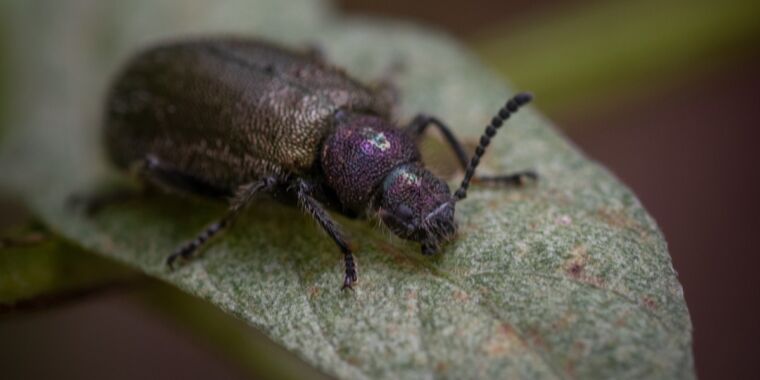
Certain species of beetle have evolved unusual “back pockets” to safely house symbiotic bacteria during metamorphosis—the only known instance of this among insects. It’s part of a mutually beneficial arrangement, since the bacteria protect vulnerable larvae and pupae from fungi. Scientists have also determined that only adult females retain these symbiotic bacteria, shuffling the populations out of those back pockets via friction to the genital area as they emerge from their pupae, according to a new paper published in the journal Frontiers in Physiology.
“We show how an insect can maintain beneficial microbial partners despite the drastic rearrangements of body structures that occur during metamorphosis,” said co-author Laura V. Flórez of the University of Copenhagen. “By modifying unique ‘pockets’ on their backs, Lagria beetles manage to keep their protective symbionts and facilitate their relocation during pupation to newly developed adult organs.”
There are many examples of microbial symbionts in nature. For instance, the Hawaiian bobtail squid has a built-in flashlight to help the creature navigate those murky nighttime waters, hunt for prey, and hide from predators in turn. It’s a special organ on the underside, a convenient little cavity that houses colonies of bacteria, Vibrio fischeri. Once that bacterial colony reaches a critical threshold, they all begin to glow, serving as a light source for the squid. Aphids, tubeworms, digger wasps, cereal weevils, and bean bugs have also evolved symbiotic relationships with microbes for various purposes.
And then there are beetles. Beetles are distinguished from other insects by front wings that harden into wing cases called elytra. Beetles undergo complete metamorphosis, i.e., overall bodily reorganization over the course of several developmental stages: egg to larva, to pupa, to the emergence of an adult from that pupal stage. So any symbiotic bacteria need to adapt accordingly during those developmental stages.
The current study focuses on two beetle species in particular: Lagria hirta (L. hirta) and Lagria villosa (L. villosa), both of which host a community of microbial symbionts throughout their life cycle. L. villosa‘s symbionts are dominated by one particular strain of Burkholderia bacteria that has lost the ability to be motile and probably could not survive for long outside their host beetles. Flórez and her research colleagues at Johannes Gutenberg University in Mainz, Germany, wanted to learn more about how the beetles maintain and protect their symbionts throughout metamorphosis.
An animated 3D micro CT scan of a pupa showing back pockets housing symbiotic bacteria.
The team collected L. hirta beetles in Germany in 2020, rearing them in an outdoor terrarium to simulate natural conditions. The offspring were collected in 2021. The L. villosa specimens were collected in Brazil in 2019 and reared in plastic containers in a climate chamber. Then the researchers compared the concentrations of symbiotic bacteria and the morphological structure of exoskeletons in males and females.
They found that the beetles had three two-lobed protective pockets at the back of the thorax during the larval and pupal stages to house symbionts. Female beetles also hosted symbionts between bristles at the back of the head. But adult males lost their symbionts, while the bacterial populations shifted to the genital area in adult females. Flórez et al. concluded that there had to be a mechanism for the relocation of the symbionts on the outer surface—especially for those bacteria species that lacked motility—and thought friction might be the key.
To test this hypothesis, five early L. villosa pupae were inoculated with fluorescent beads to simulate transmission of the symbiotic bacteria. Two of the female adults that emerged were carefully dissected, with images taken at every step to track the location of the beads. A male adult was also dissected as a control.
The results confirmed their hypothesis. “The symbionts go from the highly exposed egg surface to colonize the pockets on the back of the larvae and pupae,” said co-author Rebekka S. Janke, a graduate student at Johannes Gutenberg University in Mainz. “Finally, they end up in specialized glands associated with the reproductive system of adult females.” When the adult female lays her eggs, those symbiotic bacteria get squeezed out of the glands and deposited on the eggs’ surface, protecting them throughout metamorphosis, and the cycle of life starts all over again.
That explains why only the adult females retain their symbionts into adulthood. “In the adult stage, the main purpose of the symbiotic organs seems to be to enable successful transmission onto the egg stage and to the next generation,” said Flórez. “Since only females lay eggs, male adults do not need to carry these potentially costly symbionts and are a dead-end for the bacteria.”
DOI: Frontiers in Physiology, 2022. 10.3389/fphys.2022.979200 (About DOIs).








